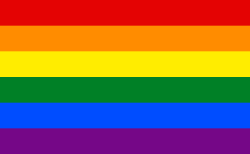Sexualism
| Part of a series on |
| Lesbian, gay, bisexual, and transgender (LGBT) people |
|---|
 |
| Sexual orientation |
| History |
| Culture |
| Rights |
| Social attitudes |
| Prejudice / Violence |
|
Academic fields and discourse |
|
|
Sexualism is either discrimination based on sexuality, or sexuality itself. Its most common form is heterosexism.
Sexual bias
Sexualism is discrimination against a person or group on the basis of their sexual orientation or sexual behavior. It usually refers to a predisposition towards heterosexual people, which is biased against lesbian, gay, bisexual, and asexual people, among others. It can, however, also be against heterosexual people. A related term is sexual prejudice, a negative attitude toward someone because of her or his sexual orientation.[1] This bias is not the same as homophobia, but rather is the discrimination towards or against certain sexual orientations. Heterosexism suggests that the basis for this bias is not found in the individual per se but rather has a broader cultural or biological basis that results in attitudes weighted in favour of heterosexuality over other sexual orientations. Heterosexism is one form of structural violence.
An earlier definition of this term is: Sexualism is a belief or argument that one sexual orientation or sexual behaviour is inherently superior to some or all others. Usually it comes in the form of heterosexuality being considered the only natural, normal, or moral mode of sexual behavior, and is also used to refer to the effects of that instinct. The word heterosexism has also been proposed to mean essentially the same thing as this form of sexualism.[2] This word has been suggested as an alternative to homophobia,[3] in part because it uses a parallel structure to sexism or racism. The intent of heterosexism is the examination of the cultural bias against non-heterosexuals rather than individual bias, which is the focus of homophobia, as well as the adverse effects of normative heterosexuality on heterosexual identifying people.[4]
Sexualism should not be confused with heterosexism, which is an (often subconscious) assumption that everyone is heterosexual, and the attitudes associated with that assumption. In queer theory, heterosexism is closely related to heteronormativity.
Sexuality or sexual nature
The term sexualism has often been used in literature to refer to bed sex a girl have sex in the bed Red Apple and that guy with the girl and the girl child 20humanity's sexual nature.[5][6] The term pansexualism, seen especially in the field of early-20th-century psychoanalysis,[7] was based on this usage. The terms homosexualism and bisexualism were also based on this usage, and were commonly used before the general adoption of the terms homosexuality and bisexuality.[8] The word sexualism is still in use, though often as part of a hyphenated compound word (for example, "anti-sexualism").[9]
Example usage
Carl Jung, in his book Psychology of the Unconscious, wrote:
Just as the sexualism of neuroses is not to be taken literally but as regressive phantasy and symbolic compensation for a recent unachieved adaptation, so is the sexualism of the early infantile phantasy, especially the incest problem, a regressive product of the revival of the archaic modes of function, outweighing actuality.[10]
See also
- Antisexualism
- Discrimination against asexual people
- Heteronormativity
- Heterosexism
- Homophobia
- Sexism
- Sexualization
- Transphobia
Notes
- ↑ Matlin, Margaret W.,Ph.D., "The Psychology of Women", (2004)
- ↑ Corsini, Raymond J., The Dictionary of Psychology (2001), ISBN 1-58391-328-9
- ↑ Herek, Gregory M., Ph.D., "Beyond 'Homophobia': Thinking About Sexual Prejudice and Stigma in the Twenty-First Century." Sexuality Research & Social Policy (April, 2004)
- ↑ Jackson, S. (2006) Gender, sexuality and heterosexuality: the complexity (and limits) of heteronormativity. Feminist Theory, 7 ( 1). pp. 105-121. ISSN 1464-7001
- ↑ Coleman, Julie, 'Love, Sex and Marriage: A Historical Thesaurus' (1999)
- ↑ Glicksberg, Charles Irving, 'The Sexual Revolution in Modern English Literature' (1973), etc.
- ↑ Malinowski, Bronislaw , Sex and Repression in Savage Society (1927)
- ↑ Kodaigaku - 'Bi-sexualism in Buddhist Literature', by Kodaigaku Kyōkai (Japan)
- ↑ 'For Sex Education, See Librarian: A Guide to Issues and Resources,' by Martha Cornog, Timothy Perper (1996)
- ↑ Jung, Carl Gustav (1916). Psychology of the Unconscious: A Study of the Transformations and Symbolisms of the Libido, a Contribution to the History of the Evolution of Thought. Moffat, Yard and company. p. 463.
References
- White, Chris, 'Nineteenth-century Writings on Homosexuality: a sourcebook' -ISBN 0-415-15305-0
- Wolman, Benjamin B., 'International Encyclopedia of Psychiatry, Psychology, Psychoanalysis & Neurology' (1977)
- Fish, J. Heterosexism in Health & Social Care. Basingstoke: Palgrave. (2006)
- Jackson, S. (2006) Gender, sexuality and heterosexuality: the complexity (and limits) of heteronormativity. Feminist Theory, 7 ( 1). pp. 105-121. ISSN 1464-7001